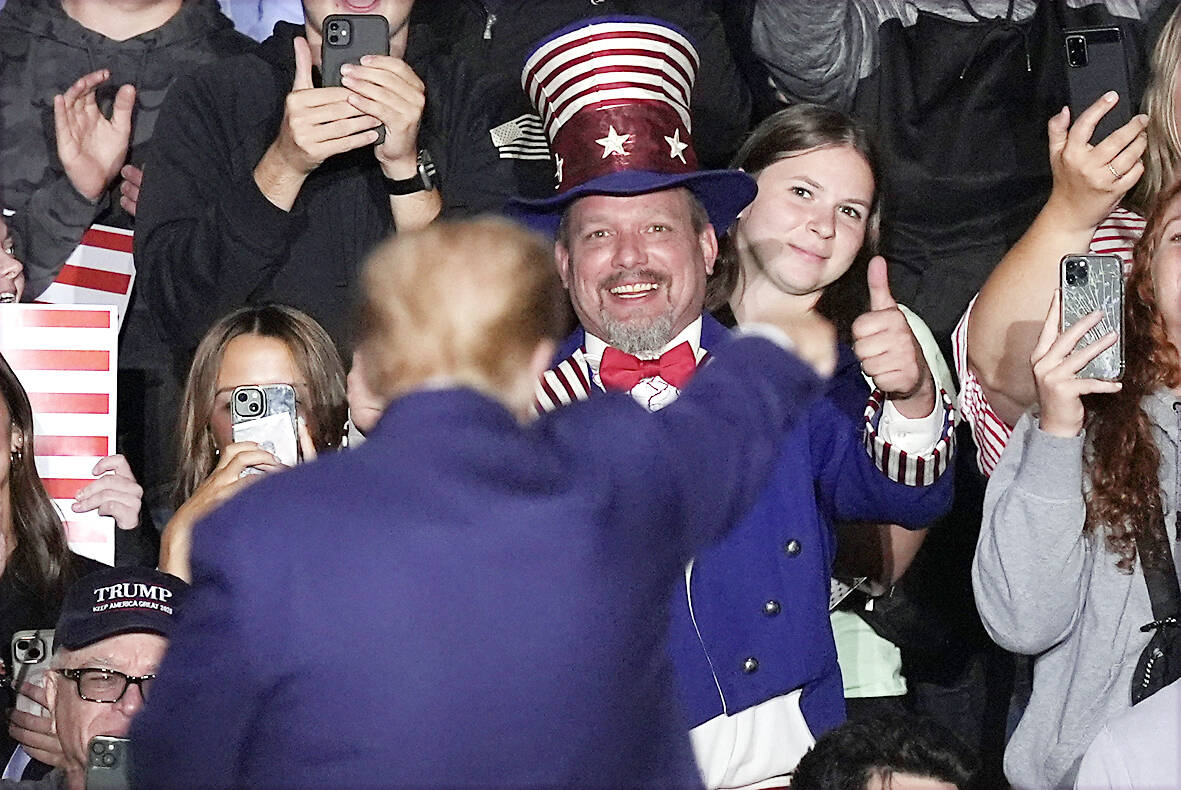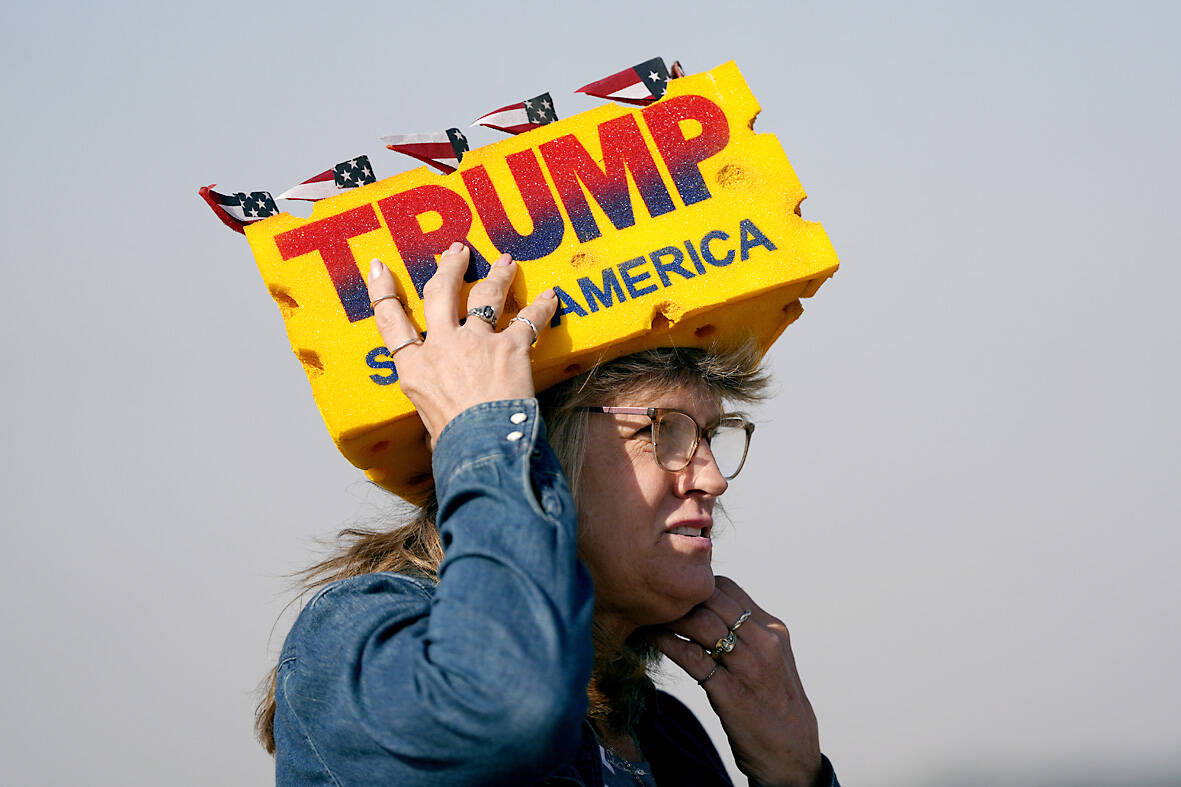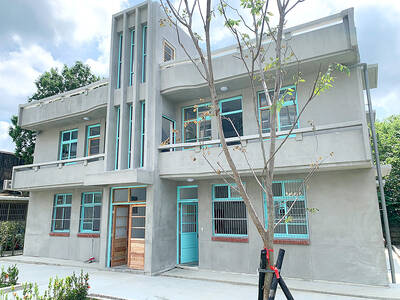From a Brooklyn studio that looks like a cross between a ransacked Toys R Us and a serial killer’s lair, the artist David Henry Nobody Jr is planning the first survey of his career. Held by a headless dummy strung by its heels from the ceiling are a set of photographs from the turn of the century of a then 30-year-old Nobody with the former president of the US.
The snapshots are all signed by Donald Trump in gold pen (Nobody supplied the pen). They will be a central piece of the New York artist’s upcoming survey in New York. This was pre-selfie and filter days. The pics are candid, unprofessional and taken by random strangers. Nobody likes the stray elements — unknown heads wandering into frame, giving sideways glances.
For the artist, they inspired a project that started — sort of — as a joke: what if Trump was president? Twenty-four years later, Nobody still isn’t quite sure whether to laugh or not.

Photo: Reuters
Born David Henry Brown Jr, Nobody’s big break as a performance artist in New York started in the late 1990s when he was working with the British artist Dominic McGill on Carpet Rollers. The pair would wear black tie and take a van to spots around Manhattan including Trump Tower and the Plaza hotel and roll out a red carpet. Then they would wait as a crowd assembled and rumors spread about what or who was coming. People would ask why they were standing there, what they were doing? Nobody and McGill never commented but rumors started anyway. Was it the Queen of Spain? Was it Trump? The idea was to “create a failure in which no one shows up in order to turn members of the crowd into momentary social critics.”
When the paired discussed work, Trump’s name came up a lot. Nobody was working before Trump hit the spotlight with The Apprentice, the reality TV show that arguably laid the groundwork for his presidency. But Trump was still everywhere, on TV, in the tabloids, making movie cameos.
“The idea of meeting Trump as many times as possible was almost like a joke passed around by me and my friends,” Nobody laughs. “He was just the cheesiest guy of all time. He struck me as a big galoot. He always had this team of people around him and he’d walk like this,” says Nobody, hunching his shoulders and clomping like Frankenstein around his studio. “He’s all-American kitsch. I just thought he was a cheeseball. I didn’t know he was a fascist yet. But behind cheese is fascism.”

Photo: AP
In 1999, Nobody managed to grab some time with the future US president six times, once when the magician David Blaine was being “buried alive” at a Trump property. Eventually, Trump began to recognize him.
“You must be a big Trump fan,” Trump told him. “Oh yeah. The biggest,” Nobody replied.
Trump was already spreading rumors that he might run for president.

Photo: AP
“It seemed like a spoof, so I thought I should make a real Trump for President sign and go and take it to the public,” Nobody said.
In early 2000 Nobody “campaigned” for Trump outside the New York Stock Exchange, a performance documented by the street photographer and film-maker Richard Sandler. As he chatted to the crowd, Nobody heard music. The film-maker Michael Moore was making a video for Rage Against the Machine’s Sleep Now in the Fire. Nobody can be briefly spotted in the crowd waving his “Donald J Trump for President 2000” sign as lead singer Zack de la Rocha sings: “And smother the rest in greed.” He has never been credited by the band or Moore for his appearance, which continued to crop up in Reddit forums and even in the Washington Post years after the event.
People’s reactions to his sign surprised him at the time — they would prove to be prophetic.
“There was a guy who said to me, ‘Hell yeah! He’s going to run the country like a business.’ Some people were really into him.”
As an artist, Nobody says, it was the image of Trump that was and remains fascinating.
“I was so into everything Donald Trump at the time that I wanted him to run. It just seemed so absurd that I thought maybe if he did, America would finally look within. But no, that never happened,” says Nobody. “The more ridiculous it gets, the less we look within.”
Nobody’s next project was to prove more controversial — and just as prescient. Posing as Alex von Furstenberg, the son of fashion designer Diane von Furstenberg, Nobody wheedled his way into celebrity parties, getting his picture taken with Bill and Hillary Clinton, Ivana Trump, Sean Combs, Sarah Jessica Parker and others. He managed to maintain the fiction of being what he calls “a fantastic nobody” for a year and became fascinated by the soon-to-metastasize allure of celebrity culture and its hangers-on.
“What I realized when you meet famous people is that you hallucinate because you’ve seen someone’s image thousands and thousands of times in mediated form, like in video and photos,” he says. “It’s like an information hallucination almost.”
Celebrities themselves didn’t really interest Nobody.
“They are generally so boring,” he says.
But at the opening of Nobody’s von Furstenberg show he realized he had tapped into a dark vein. The exhibition made the news and triggered a scandal. Someone threw a pie in his face at the opening, lies and disinformation started spreading.
“People thought I was a millionaire, they thought the whole crowd were all fake people, that the camera crew was fake. And that’s when I realized I looked into the heart of America, just the delusion of the whole thing.”
In some ways, says Nobody, these were simpler, less overwhelming times. The stars he was seeing in real life were glimpsed on TV, at the movies, in magazines but there wasn’t the always on, always available access to celebrity that now coats our life.
“Back then, when you would go to the movie theater you would leave the theater and then walk around and for a little while, everything in life would resemble the movie theater or the movie that you just saw. But the Internet is actually doing that to you 24/7, and we don’t even realize how much it’s doing to us.”
For a long time, the reaction of the von Furstenberg pieces eclipsed the Trump work.
“I didn’t really think much about it until he became president in 2016. Then I got calls from a bunch of people saying: ‘Holy shit dude, you predicted the future!’” he says. “And I did it before The Simpsons.”
The Simpson’s episode Bart to the Future referencing a Trump presidency aired in March 2000, months after Nobody’s project began.
These days Nobody works mainly in video and photography, making portraits that are somewhere between Giuseppe Arcimboldo, Cindy Sherman and Nickelodeon. In Mental Marionette With Dancing Dogs, a red-eyed, grey-wigged Nobody stares forlornly at the camera as a baby doll strapped to his head “plays” the drums and pulls the strings of a set of hotdogs attached to the artist, two of them up his nose. In Hamburger Helper, Nobody’s blackened eyes stare out from a giant mitt made of minced meat. Food plays a big role in a lot of the work. Milk and cereal, energy drinks, assorted vegetables. Is that peanut butter? I hope so.
“The newer work really deals with how your life on your phone is a primary behavioral architecture for how you exist, how you live in real life, way more than just being on your phone. It’s way beyond that. It’s in everything. I feel like when I’m talking to young people now, basically they see me as image and caption as if we’re on social media in real life,” he says.
The pieces play with some of the same themes that pulse through his earlier work — transformation, image versus reality, the ways we project an image of ourselves, how we create our image of others. Even the (in Nobody’s case, literally) cheesiest images have power.
“This sort of cheesy kitsch is very conservative. It’s like conservative person’s art, and there are weird ethical and religious fantasies in it. Take Trump Tower, for example. It represents the American dream to people, doesn’t it? It’s a fantasy. I am not saying they’re wrong all the time, either. I don’t want to come across as just a snotty leftist. I mean, it’s an incredibly powerful myth that he’s created, isn’t it?”

June 2 to June 8 Taiwan’s woodcutters believe that if they see even one speck of red in their cooked rice, no matter how small, an accident is going to happen. Peng Chin-tian (彭錦田) swears that this has proven to be true at every stop during his decades-long career in the logging industry. Along with mining, timber harvesting was once considered the most dangerous profession in Taiwan. Not only were mishaps common during all stages of processing, it was difficult to transport the injured to get medical treatment. Many died during the arduous journey. Peng recounts some of his accidents in

“Why does Taiwan identity decline?”a group of researchers lead by University of Nevada political scientist Austin Wang (王宏恩) asked in a recent paper. After all, it is not difficult to explain the rise in Taiwanese identity after the early 1990s. But no model predicted its decline during the 2016-2018 period, they say. After testing various alternative explanations, Wang et al argue that the fall-off in Taiwanese identity during that period is related to voter hedging based on the performance of the Democratic Progressive Party (DPP). Since the DPP is perceived as the guardian of Taiwan identity, when it performs well,

The Taiwan People’s Party (TPP) on May 18 held a rally in Taichung to mark the anniversary of President William Lai’s (賴清德) inauguration on May 20. The title of the rally could be loosely translated to “May 18 recall fraudulent goods” (518退貨ㄌㄨㄚˋ!). Unlike in English, where the terms are the same, “recall” (退貨) in this context refers to product recalls due to damaged, defective or fraudulent merchandise, not the political recalls (罷免) currently dominating the headlines. I attended the rally to determine if the impression was correct that the TPP under party Chairman Huang Kuo-Chang (黃國昌) had little of a

At Computex 2025, Nvidia CEO Jensen Huang (黃仁勳) urged the government to subsidize AI. “All schools in Taiwan must integrate AI into their curricula,” he declared. A few months earlier, he said, “If I were a student today, I’d immediately start using tools like ChatGPT, Gemini Pro and Grok to learn, write and accelerate my thinking.” Huang sees the AI-bullet train leaving the station. And as one of its drivers, he’s worried about youth not getting on board — bad for their careers, and bad for his workforce. As a semiconductor supply-chain powerhouse and AI hub wannabe, Taiwan is seeing